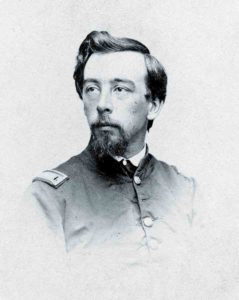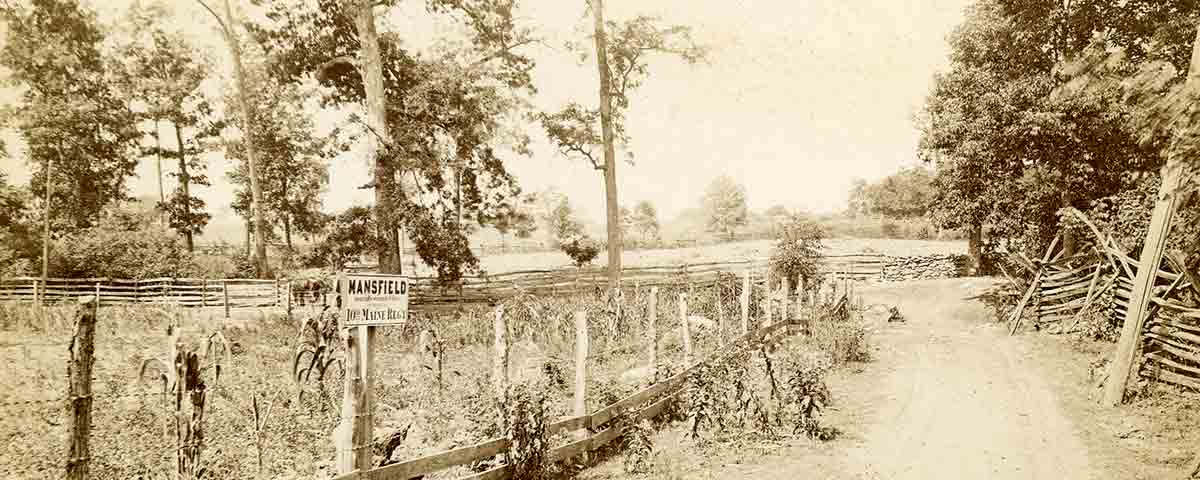During the East Woods fighting early in the Battle of Antietam, the 10th Maine Infantry found itself hotly engaged with Confederates concealed within the woods. Looking to his right at one point, Lieutenant John Mead Gould, the regiment’s adjutant, happened to notice several mounted men on a nearby knoll, including his corps commander, Maj. Gen. Joseph King Fenno Mansfield, who was frantically motioning at the 10th to cease firing. “As this was the very last thing we proposed to do,” Gould recalled, “the few who saw him did not understand what his motions meant, and so no attention was paid to him.” In response, the 58-year-old Mansfield, accompanied by a single orderly, galloped in their direction, shouting that they were firing on their own men. But when he reached the regiment’s left flank, an officer and a sergeant in Company C raced up to inform him that he was mistaken and pointed at several soldiers, clearly Confederate, now only about 20 yards away. Mansfield had no time to react. Within moments, he had been shot through the lungs.
Gould was the first to reach the general, and with the assistance of three comrades carried him to the rear. Soldiers from the 125th Pennsylvania lent help, and also provided a blanket, as Mansfield was transported back along the Smoketown Road to a woodlot where Gould had located an ambulance and two medical officers. Mansfield was loaded on the ambulance and taken to the George Line Farm, about a mile to the north, but would die of his wounds the following morning.
The 22-year-old Gould was an intelligent, observant young man from Portland, Maine. In 1861 he had enlisted in the 1st Maine Infantry, a three-month regiment. Upon his discharge from the 1st, Gould promptly enlisted in the newly forming 10th Maine, a two-year regiment. He was promoted to sergeant major, then to second lieutenant, and in August 1862 to first lieutenant. The latter promotion meant Gould would serve as the regimental adjutant, a position that typically required a bright person with good attention to detail.
Throughout the war Gould maintained a detailed diary and devoted considerable space to the Battle of Antietam and to Mansfield’s mortal wounding. But by early December, when Gould still hadn’t seen anything in print about the events surrounding the general’s death, he composed a memorandum about what had unfolded before him that day. He also sent a detailed letter to Mansfield’s widow describing what had occurred.
Perhaps because of Mansfield’s death, Antietam became a lifelong fascination for Gould. In 1890, curious about what Confederate units his regiment fought in the East Woods, he began looking for answers by corresponding with Confederate veterans. An 1892 account he wrote for the National Tribune, however, would be disputed by veterans of the 125th Pennsylvania, who claimed Gould was “radically and entirely mistaken when he says that General Mansfield was killed in front of his regiment.” Gould was energized by this questioning. As a combat veteran he understood how the chaos of battle could cloud the memories of some participants. He began eagerly exploring all aspects of the battle not only surrounding Mansfield’s wounding but also the fighting elsewhere in the East Woods and the nearby Cornfield. He wrote and received hundreds of letters from veterans of nearly every regiment and battery in the Union 1st Corps (Hooker’s) and 12th Corps (Mansfield’s), and Confederates from John Bell Hood’s, D.H. Hill’s, and Alexander Lawton’s divisions.
Gould was tireless, methodical, and thorough in his efforts to track down men from every unit that fought in those sectors of the battlefield. If, for example, he could find no contacts for a Confederate unit, he often wrote the postmaster in a town he believed might have veterans from a certain regiment and asked him to deliver his circular letter to them. Rarely did he come up empty-handed. Former Confederates sensed that he bore no grudge against them and was genuinely interested in their side of the story and in getting at the truth of what had happened during the battle. Most replied eagerly and graciously to Gould’s inquiries.

Ben Millikin of the 27th Georgia for instance, wrote Gould three letters in 1895, one of 18 pages, and the others both eight pages long. J.D. Smither of the 5th Texas, at the end of a 13-page letter, apologized; “Pardon the loquacity of an old soldier. You know when they start they never know when to stop off.” Such lengthy letters were typical and Gould responded to them all. Millikin grew so fond of Gould through their correspondence that he encouraged the New Englander to invest in a local bank in Millikin’s home town. Gould had a dry sense of humor and often joked with his former enemies. In responding to a letter from Millikin, Gould wrote, “Now all you fellows of the 27th fought well—most too well to suit me—but such a poor set of correspondents I never struck.”
Because Gould was a veteran, his correspondents tended to be frank and honest with him. An example was Lewis Stegman, a captain with the 102nd New York, who minced no words when he described Lt. Col. James C. Lane, the regiment’s commander at Antietam, as an “incubus” and added, “[W]hen his name is mentioned it is with a damn.” A corporal in the same regiment concurred, writing Gould that he grouped Lane with “the brigade of coffee cooking, sneaking hospital bummers.” John Rankin, a 27th Indiana veteran, fumed about veterans who exaggerated things. “What is it about war that upsets men’s intellects and starts their minds wandering over a vast ocean of fiction,” he wrote.
Gould became an expert on the battle on the northern end of the field and often included notes in the margins of letters when veterans made mistakes. In an 1891 letter, former Confederate Brig. Gen. Evander M. Law made an error regarding the 5th Texas. At the bottom of Law’s letter Gould wrote, “In my answer I tried to set him right on the matter of the 5th Texas & to tell him all I had learned so far. It was perhaps too much for the General. He never wrote again! JMG.” When W.T. Hill of the 5th Texas wrote that there was a “fearful slaughter” of Union troops in his regiment’s front, Gould, who knew better, noted, “So it appeared to most of them.”
Gould shared all that he learned with Ezra Carman, former colonel of the 13th New Jersey, who in the 1890s was the government historian at Antietam tasked with marking the positions of both armies on the field. Much of what Carman learned of the battle around the Cornfield and East Woods came to him via Gould. Today, Gould’s Antietam collection resides at Dartmouth College. Except to careful Antietam students, he is largely unknown, but much of what we know about the fighting in those sectors of the battlefield the morning of September 17 is the result of Gould’s exhaustive efforts to uncover as much of the truth as possible.
Scott Hartwig writes from the crossroads of Gettysburg.





